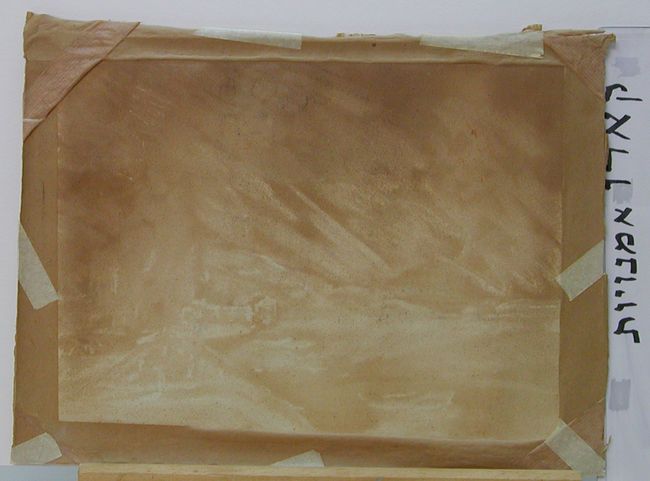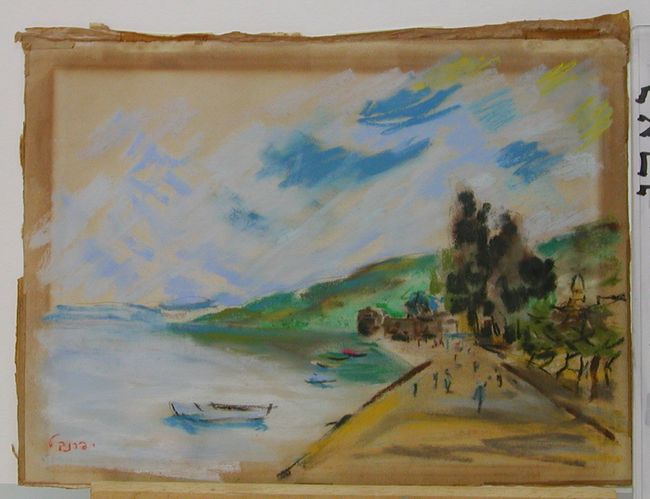Conservative Framing – Why and how to frame pictures
Conservative Framing (also called Museum Framing, Acidic-free Framing)
An example of an artwork that was damaged by acidic and injurious effects of ordinary framing – the artwork is performed in a mixed Franel technique (gouache, aquarelle and pastels)
|

To enlarge
Back of the painting
|

To enlarge
Face of the painting
|
Throughout the world air pollution injures artwork. Even marble and bronze sculptures that are apparently resistance to wear and tear are increasingly subject to deterioration. Despite public awareness of this phenomenon we often allow artworks with sensitive or financial value to deteriorate in our home due to failure to use conservative framing also known as museum framing.
Even veteran framers often forget to remind us and to explain the damage that can be caused to a valuable artwork by ordinary framing.
Which works should be correctly framed?
- Original artworks of all types
- Original graphic works (etchings, lithographs, silk prints etc.)
- Any item with sentimental or financial value or works anticipated to have such value in the future.
The most sensitive and vulnerable artworks are those performed on paper, even high quality paper is not immune to damage!
Conservative framing neutralizes the major adversaries:
- Acids which exist in any wood, and in paper products that undergo regular framing that burns the paper, changes colors, causing fragility to the extent of disintegration.
- Humidity levels of more than 55% (RH) cause an increase in mold and weaken the paper and pigments, causing the separation of paint levels.
- Sulfur dioxide and other air pollutants that cause alteration of colors and acceleration of natural weathering processes
- Insects such as the silverfish and book lice that gnaw the paper and stain the paper with their excretions.
What is the proper way to perform conservative framing?
There are several simple rules, which if followed will preserve your artwork for many years:
- The structure of the framing should be appropriate for the technique and materials used in the artwork according to the most sensitive component that it includes (the strength of the spine is determined according to its weakest vertebra).
- All the materials that come in contact with the artwork must have a PH value of between 7.5-8.5, with a filling or supplement of 3-5% calcium carbonate that neutralizes injurious, acidic materials.
- At its highest point, the artwork should be at a distance of at least 5mm from the glazing.
- A controlled micro-climate should be created in which the relative humidity is constantly 45-55%. This is especially important in a home where there is no climate control as there is in museums – in other words the frame should be hermetically sealed.
- The type of glazing should be appropriate for the media and for the environment and if necessary UV filters or acrylic plates should be included.
- Preventive treatment should be applied against insects and mold and for all the framing components before sealing, by fuming with Phenyl-Penol or Thymol.
- There should be no use of harmful materials such as masking-tape, cellotape, acidic cardboard or materials containing lignin (corrugated cardboard Etc.).
- No irreversible process should be used such as adhering, cutting an artwork (even invisible parts) without the explicit permission of the artist.
- Works on canvas require special treatment including exclusive protective backing against humidity and dust which nevertheless allows the canvas to 'breathe'.
- The frame should be lined to prevent abrasion and pressure on the painting, the painting should be held within the frame with flexible clips that allow the artwork to expand and shrink naturally, and not with nails as most framers do.
- The profile of the frame's molding should be proportionate – it needs to undergo treatment on the inside as well in order to prevent transfer of the wood's acidity to the artwork, and to prevent absorption of humidity and its transfer to the artwork. Today there are polypropylene profiles that are not sensitive to humidity and completely resistant to woodworm, and they constitute the best solution from the conservation point of view. Metal frames are not hermetically sealed.



